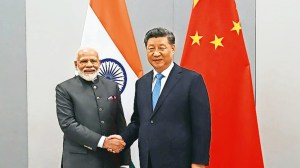Nader here nor there
Any social scientist trained in the American tradition with heavy reliance on statistics would readily acknowledge, election results, like...

Any social scientist trained in the American tradition with heavy reliance on statistics would readily acknowledge, election results, like census, are exemplars of "noisy" data, which is to say that they could only be accurate within some finite band of error. What the US election results have revealed, though, is something larger than Ralph Nader’s spoiler effect and the electorate’s statistically corroborated indifference towards either of the two major candidates.
Ever since World War II, the two parties have worked hard to corner identifiable segments of the political market and, by the 1960s, seemed to have developed quite an effective strategy for doing so. Thus, while Democrats became identified with labour, civil rights and the environment, Republicans were supposedly champions of traditional values.
But, given the two-party formation, such a clear distinction along ideological lines was actually convenient to both parties as well as to organised interests who worked hard behind the scenes to lobby for legislation that often had little or nothing to do with the parties’ stated loyalties. Indeed, automobile, tobacco, oil, insurance and banking interests enjoyed equal power among both Republicans and Democrats, as did several other smaller groups lobbying for their clauses to be inserted into national and state-level legislation.
Following the 1980s, globalisation, the end of the Cold War and economic restructuring in manufacturing, agriculture and services, severely altered the demographic landscape of the US. In rural areas, family farmers found their occupations under risk from large corporations and were forced to either sell their land or enter new niche markets. Unlike similar changes in the rest of the industrialised world, the so-called "peace dividend", namely the diversion of some unproductive military spending to productive uses, and the revolution in personal computer use, telecommunications and the Internet have kept a steady flow of dollars circulating through the economy. Thus, unemployment in the late eighties reached historically low levels, although real wages in services and agriculture fell. At the same time, the rise in income from speculative ventures was dramatic, and just as impressive as the creation of a new breed of dot-com millionaires was the growing wealth of persons engaged in ancillary occupations,like real estate.
During this period, both traditional labour and southern conservatives lost some of their dominance and the locus of power seemed to shift to an as yet identified set of political groups. Political scientists have pointed out that although citizens most closely affiliated with the parties took increasingly polarised positions, "average" interests were slightly less conservative than before. Debates in the Senate and the House and also in the state legislatures appeared to be getting more fractious over social policy affecting race, gender and sexuality, but far less so over domestic economic policy and certain aspects of foreign policy. In part, this seemed to reflect the economic rise of social groups like blacks, Latinos, Asians, women and gays, particularly in and around urban centers, on the one hand, and the growing popularity of conservative talk show hosts, evangelists and the like, on the other.
Paradoxically, political campaigning on both sides continued to attempt to capture an elusive "middle". Both parties also relied heavily on corporate campaign contributions, which meant that although their divisions with respect to social policy were impacted by their loyalties to voter groups, their convergence on economic policy reflected the resurgent lobbying power of multinational corporations. Both parties, therefore, found themselves competing for the same corner of the electoral market, even while they were forced to pretend there continued to be important enough ideological differences between them.
It was in these circumstances that the space for third-party politics was first tested in 1992, when Ross Perot injected his personal wealth and iconoclastic attacks on the political establishment. Nader’s campaign, although it had important ideological differences with Perot’s, was curiously similar to Perot’s in its attacks on the two main parties. He accused them of being beholden to special interests rather than to people. In the end, although Nader got barely more than 2 per cent of the popular vote, he seemed to tap into many of the same constituencies as Perot: Predominantly young white male first-time voters who identified themselves as independent rather than with any party affiliation. Nevertheless, if the recent popular protests against the WTO, IMF and the World Bank in Seattle and Washington are any indication, Nader’s support is far deeper and more affirmative than a merely negative vote for the two major parties. Indeed, given the oddly perfect split in the vote in the House, Senate and thePresidential race, the idea of third politics has already firmly wedgeditself into the popular imagination and will only grow over the next four years. Just as the restlessness of three decades ago caused a bard to record the radical ways in which culture were getting transmuted, now too, "the times, they are a-changing".
The writer is a Boston-based political theorist
Photos



- 01
- 02
- 03
- 04
- 05



























